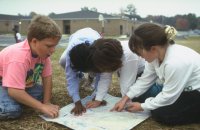Teaching Target Language Vocabulary With Micro Field Trips
For both English learners and world language students, getting out of the classroom can make learning new words more engaging.
Your content has been saved!
Go to My Saved Content.Task-based language teaching, the practice of learning through student-centered meaningful tasks, makes a target language come alive for students both in and outside the classroom. Using audio and visuals in any literacy classroom is important, particularly when working with English language learners, and research from the National Reading Technical Assistance Center shows that students learn target language vocabulary more effectively when they engage with it in a variety of ways.
For these learning experiences to be most effective, students should be physically active while completing them. Education professor Susan Griss writes about the benefits of using movement to increase student engagement: “By creating a rich contextual environment, kinesthetic learning constructs memories connected to time, place, and emotions, which we call episodic encoding. Students in grades pre-K through 12 activate and integrate physical, emotional, and cognitive responses to what they are learning, making learning more meaningful.”
One great way to do this is to take micro field trips, short outings that can be completed in a single class period.
Micro Field Trips
Before departing the classroom, introduce the task and review behavioral expectations.
While on the field trip, it may be helpful to have clipboards or pieces of cardboard for students to use in taking notes. To document the experiences and vocabulary they encounter, students might draw or take notes in a journal or on a handout or flashcards. Students might also take photographs and videos of their experiences that can be later shared in the classroom.
Below are some of the many places you might go.
Campus grounds and nearby parks: Take a micro field trip to your school’s yard or a local park to enhance a unit on nature and wildlife while reinforcing vocabulary for senses, colors, and the concepts of quantity and size.
Together, the class might create a word wall composed of pictures that were taken or drawn on your walk. What physical geographic features did they see? What kinds of animals? Afterwards, students might write descriptive stories set in the place you visited using vocabulary collected and defined together by the class.
To prepare for this micro field trip, group word wall project, and individual writing task, review the vocabulary students will likely see and experience, and include corresponding images.
Corner grocery store: Reach out to local shops to ask about bringing your class in. Visiting a grocery store could enhance a unit on food, cooking, and senses. Schools in remote areas might create a simulated grocery store in the classroom with recycled food packaging.
Individually or in small groups, students could write a recipe and budget for a favorite dish, which might be something that celebrates their family’s traditions. Students could then prepare their recipe to share with the class, and then write reviews of each other’s dishes.
For international language classes, students could also learn to prepare food from a region where their target language is spoken, like cooking tortillas for Spanish class.
Local street: As part of a unit on transportation and travel, classes could take a micro field trip to the street outside of school. Students could have a photo scavenger hunt to document and practice vocabulary that describes road features and transportation. They could then create and present travel brochures about the neighborhood the school is in or write a poem or short story about something they saw on their walk.
Making It Happen
To make micro field trips logistically feasible, consider having parents or guardians sign “walking permission slips” at the beginning of the school year that authorize teachers and staff to take students on walks outside the school building without having to obtain additional prior approval. Sample permission slips can be found here, here, and here.
